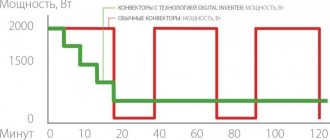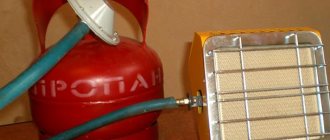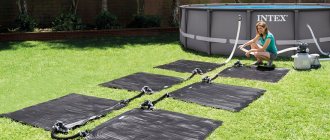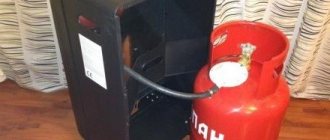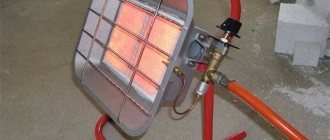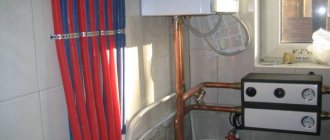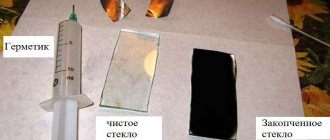The house should be joyful, cozy and warm. And if the first two points can be accomplished absolutely free, then you will have to fork out for heating - everyone wants to live in a warm house. When it comes to heating a dacha, things are more difficult, because such a building, as a rule, is not permanent, so it easily transmits heat and cools down quickly. In this article we will talk about such a portable heating device as a gas cylinder heater - how to choose it, where to buy it and how to install it in a hunter’s and fisherman’s tent.
Advantages of gas infrared heaters
This type of device has a number of undeniable advantages, which is why it has become widespread.
Main advantages:
- There is no connection to the electrical network. The heater can be placed anywhere.
- Large devices can also operate if connected to a centralized gas supply system.
- Can be used outdoors and indoors of any type and purpose, even in tents and awnings.
- The device is easy to transport and repair due to its small dimensions.
- Characterized by high efficiency due to combined heating systems.
- On some models you can also heat and cook food.
The reliability of the system can be increased by installing special sensors that respond to excess concentrations of carbon dioxide in the air. This will help reduce the risk of poisoning hundreds of times. In this case, heaters do not emit carbon monoxide, so in fact they cannot be deadly to humans.
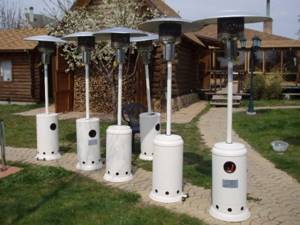
Operating principle of the device
The operating principle of the heater is very simple and is based on the basic laws of thermodynamics. All processes are explained by the design of the device.
In general terms, when describing the operating principle, the main aspects can be identified:
- The gas from the cylinder enters the reducer, where the propane pressure is reduced, after which it safely enters the heater nozzle.
- The gas is mixed with air, and the total mixture enters the ceramic panel.
- The gas burns evenly, so there are no by-products - ash, smoke, fog, carbon monoxide.
- The gas heats the ceramic element, which transfers heat through infrared radiation - glow.
The device evenly heats the air and surrounding objects, therefore it has very high efficiency. The heater can be used in an apartment, cottage, garage, tent and even outdoors. Depending on the specific application, the dimensions of the device may vary.
The gas air heater consists of the following elements:
- metal case;
- heat exchanger;
- divider;
- automatic control unit;
- gearbox
The use of heaters has a number of features. In order for the device to heat the maximum area, it must be placed high above the floor surface. Only the illuminated part of the space is heated. It is also very important to follow safety precautions during operation. This will be discussed in detail at the end of the article.
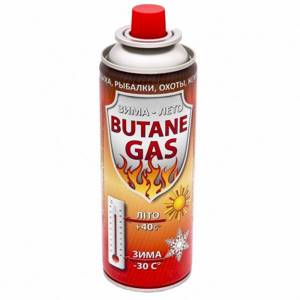
Calculation of gas consumption from cylinders and operating time of a gas convector
How long will a gas heater last on one cylinder? This question worries many suburban residents. Let's look at the consumption of Pavel V.
The gas convector has 3 power modes - from 1 to 2.3 kW. A 50-liter cylinder is filled with about 42 liters of gas, because... the container is filled to approximately 85% of its full volume. One liter of gas contains 0.545 kg of fuel (if the summer mixture is 50% propane and 50% butane) and 0.517 kg of fuel (if the winter mixture is 90% propane and 10% butane).
This means that in a 50-liter cylinder, on average , (depending on the type of gas - “summer” or “winter”) 22 kg of fuel . The convector consumes:
- In the first power mode - 100 g of fuel per hour.
- In the second power mode - 200 g of fuel per hour.
- In the third power mode - 300 g of fuel per hour.
In total, the convector will work:
- 1st mode – 220 hours.
- 2nd mode – 110 hours.
- 3rd mode – 73 hours.
Knowing the amount of fuel (in kg) in cylinders of different displacements and the fuel consumption of the heat generator at different power modes, you can estimate the operating time of the gas convector and the cost of this type of backup heating.
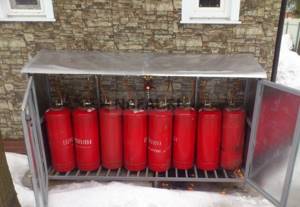
To determine the volume of remaining gas, it is necessary to weigh the cylinder with the mixture, subtract the weight of the container from its mass and calculate the remaining fuel depending on its density (0.545 kg/l or 0.517 kg/l).
Types of gas cylinder heaters
The devices are divided into several groups depending on operating conditions, functionality, appearance and dimensions. Let's look at the main types of heaters.
Small floor-standing
Small-sized bottled gas heaters can be used in a wide variety of conditions. However, they are allowed to be used only in spacious, well-ventilated rooms and open areas. The cylinders are connected to the device through reducers or using a special valve (if the cylinders used are very small). For ease of use, the device is equipped with metal legs.
Certain types of small-sized models of gas heaters look like a regular stove, so they can be used not only for heating a room, but also for cooking.
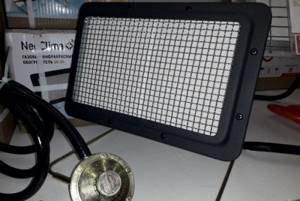
Heaters with built-in cylinders
Such devices are very aesthetic, reminiscent of an air freshener. The cylinders are installed in a beautiful housing, inside of which burners and automatic control systems are located. Moreover, cylinders can be very large and have a capacity of up to 27 liters. Models can be used for heating open areas and ventilated rooms. The main advantages of this variety are neat execution and compactness.
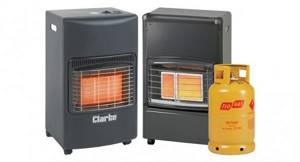
Outdoor heaters
They have a beautiful appearance, reminiscent of small street lamps. The devices are characterized by a circular directional zone, so you can effectively heat open areas and verandas. To power the devices, built-in or connected gas cylinders are used. Most often, built-in gas containers are located on special legs-stands, and connected ones are connected through gearboxes. The heater itself has a wide base, so it is highly stable.
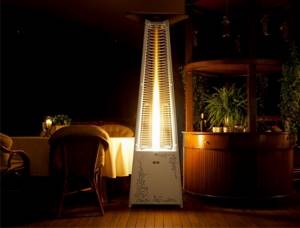
Combined
They look like a solid battery with a grid. Combined types can be used to heat open areas, semi-enclosed verandas and terraces, and ventilated rooms. The devices can heat the air and the surrounding space simultaneously through infrared radiation and convection. For this purpose, the device is equipped with special burners. The main advantage is the versatility of use of this variety.
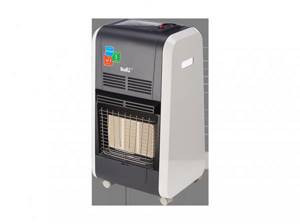
Catalytic
The heating process is carried out due to the oxidative reaction of the reagents. In this case, gas fuel does not burn, but is oxidized in the presence of catalysts, releasing a large amount of heat. During the process, the fuel consumes a minimal amount of oxygen and does not emit harmful reaction products. The device is universal in use - it can be installed outdoors and in any room.
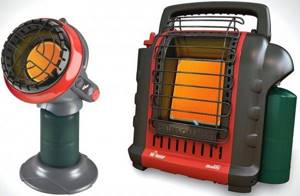
Tent heaters
Due to the nature of their application, such devices are small-sized and have increased operational safety. The cylinders in this case are very compact and have a small capacity. The device consumes gas quite economically, but the device can hardly be called durable - it is unlikely to work longer than three nights.
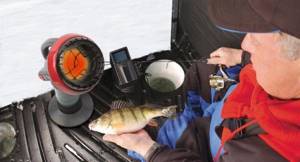
Advantages and disadvantages

Models powered by gas fuel have the following advantages:
- Aesthetic appearance. You can buy a gas lantern-heater for the veranda and outdoors in any color and any design.
- Availability of fuel. Natural bottled gas is one of the cheapest types of raw materials.
- Mobility. Can be moved thanks to the presence of wheels on large models.
- Several power modes.
- Simplicity of design. The absence of complex elements increases the service life of devices and improves their reliability.
- Good efficiency due to high efficiency.
- They operate in the range from -40°С to +40°С.
- Environmentally friendly. Gas combustion products are harmless to the environment.
- Easy to use.
- Heating rate. The devices quickly adapt to changes in parameters.
- Safety. The heaters have a multi-level protection system, due to which the risk of fire and other dangerous situations is minimal.
- Durability. The validity period may exceed 10 years.
The disadvantages are the following:
- The need to control the availability of fuel. Periodically you need to replace the gas canister after it runs out.
- Price. The price of the device depends on its functions, design and purpose.
- Risk of gas leakage. The gas itself is toxic, so its leakage is harmful to health and can be fatal.
- Limiting the time spent near the heater. IR rays negatively affect a person when they remain in their area for a long time.
- It is necessary to carefully consider the ventilation system when installing it yourself. Otherwise, the chamber will not receive enough oxygen necessary for combustion.
Despite the shortcomings, outdoor gas heaters do their job well and have proven themselves to be reliable and high-quality equipment.
How to choose the best
You need to approach the choice of a heater very responsibly, because not only the quality of life, but also your safety will depend on it.
Determining criteria for choosing a gas heater:
- Place and operating conditions: the mobile heater can be used both outdoors and in the apartment.
- Power and desired heating temperature.
- Approximate operating time.
- Safety – equipped with a special carbon dioxide sensor.
- Cost of the device.
The minimum cost of the device ranges from 800-1000 rubles - the power of such a heater is 2-2.5 kilowatts. It is not wind resistant so should only be used in sheltered areas or indoors. It is also important to consider the operating time: 5 liters of gas burn out in about 10-11 hours.
The universal calculation looks like this: to heat one square meter of area you need to spend 70-100 watts. It turns out that one heater with a conventional power of 1 kW is enough to heat 10 square meters. Gas consumption for a 1 kilowatt heater will be approximately 90 grams of gas per hour.
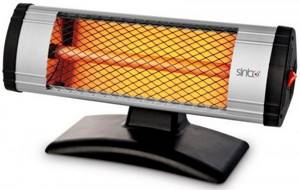
The best mobile devices for home and garden
Bartolini Pullover K
A very high-quality gas inverter heater made in Italy, designed for heating various types of premises: houses, apartments, cottages, outbuildings. Can serve as the main or additional source of heat. The device is very mobile thanks to wheels. The catalytic panel is made of fiberglass, the catalyst is platinum powder, so the device does not emit harmful oxidation products.
Fuel – liquefied propane-butane. Combustion is not accompanied by the release of carbon monoxide. The cylinder (volume 27 or 24.5 liters) is placed inside the housing and covered with a casing. The device has a reliable power regulator.
Equipped with safety elements:
- burner flame level control sensor;
- rollover protection (automatic shutdown when tilted);
- carbon dioxide sensor.
The device is silent, reliable, and has large dimensions. The cost is relatively high - 10,700 rubles.

Timberk TGN 4200 SM1
Inexpensive universal infrared heater for heating premises of various types and purposes. Powered by a propane-butane cylinder (volume 12 liters), which is easily placed inside a metal case. Connection is made through a reducer, gas hose and clamps, which are included in the kit.
Heating is carried out by IR radiation of ceramic plates heated by a gas burner. Combustion products are released in small quantities, are safe and do not have an unpleasant odor. There is rollover protection, piezo ignition, power regulator and carbon dioxide sensor. The price of the device is 5400 rubles.

Best garage heaters
Solar gas GII 2.9
Gas infrared burner designed for local directed heating of rooms with a lack of free space. Can be used as a small stove for heating or cooking food, as well as for drying surfaces during painting work. The standard power is 2.9 kW, but you can find analogues of 2.3 or 3.65 kilowatts.
The German ceramic emitter is very reliable and durable, ensuring uniform flame distribution. The device is mobile, lightweight (weighs 2 kg), autonomous and inexpensive. Thermal radiation is direct and secondary in nature (due to heated surfaces), so the device has high efficiency. Low cost (950 rubles) is a big plus for an infrared heater.
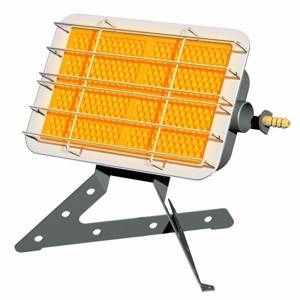
Caliber TPG-10
A gas heat fan (heat gun) serves as the main heat source for effective heating of utility rooms: garages, car service centers, warehouses, hangars. The device runs on propane or butane. The kit includes a reducer with a pressure gauge to correctly connect the can. Heater power – 10 kW.
The device is compact (it can be transported in a car), reliable and durable. Equipped with a grill to protect against foreign objects. Costs 4100-4200 rubles.
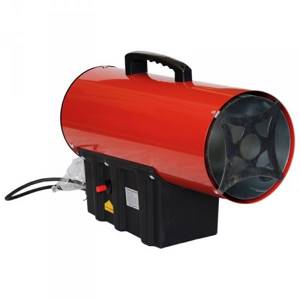
Best Portable Tent Heaters
Pathfinder Ion PF-GHP-S01
The camping device was specially designed for the Russian market. Indispensable for fishermen and hunters. Designed for heating shawls, tents, country houses, lodges. Fuel - liquefied gas from cylinders with a threaded valve of 230 or 450 grams. You can purchase additional adapters to heat a larger area. Characterized by very economical fuel consumption. The price for the device itself is also pleasing – 3800 rubles. Reviews about the unit are positive. The only negative is that adapters are not included in the kit; they will have to be purchased separately.
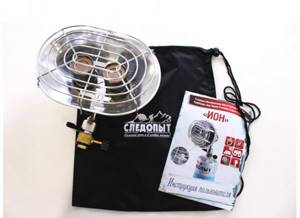
Kovea Fire Ball KH-0710
Portable infrared gas heater with hose. This tourist model is started using piezo ignition.
Different reflector positions can perform different functions:
- The inclined position is responsible for heating the room.
- The horizontal one is used for heating and cooking food.
The reflector can be securely fixed in both positions using bolts to prevent the heating direction from changing or the dishes tipping over during cooking. The device operates stably at low temperatures thanks to the gas preheating system. Powered by gas cylinders with threaded connections. It is the best option for fishermen, because it helps to quickly dry any things if necessary. Cost – 6300 rubles.
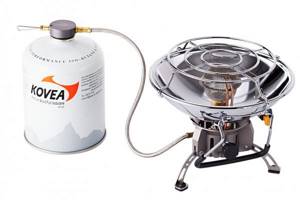
The best outdoor heaters
Enders Elegance
Exquisite model from a German manufacturer. Effectively heats the air within a radius of 4.5 meters around itself. Can be used for heating verandas, terraces, and various open areas. Made in an elegant stainless steel case, the heating pads are made of alloy steel. Ignition is carried out using a piezoelectric element, and gas is supplied from a cylinder weighing 11 kilograms. Very economical and highly efficient latest model.
Duration of work – more than 50 hours. Safety at the highest level: the system turns off the gas supply when the flame goes out, and a tilt of more than 45 degrees leads to automatic shutdown of the entire installation. Due to the design, the cost of the devices is high - 22,000 rubles.
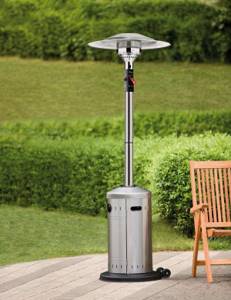
Ballu Bogh-14E
It has a very aesthetic appearance, so it can decorate any terrace or outdoor cafe. The body and fastening elements are made of high quality stainless steel. The unit is large, but very mobile thanks to the built-in wheelbase.
The uniqueness of the model is that turning it on, off and adjusting can be done manually using a panel on the device body or a remote control. The settings provide three options for setting the flame height, thanks to which you can change the heating temperature and the degree of illumination. Such a high-tech device is expensive - 39,900.
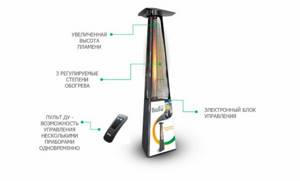
Construction of a heater from a pipe
This homemade design is also called a thermal gas gun. It produces significantly more heat than previous heaters and absorbs more energy resources. Also, such structures are often equipped with chimneys, which makes them bulky and difficult to carry.

The diagram will familiarize you with the principle of operation and design features of a gas heat gun. The heat flow generated by the device is distributed using a fan
To assemble the heater yourself, you need to collect the following material:
- three meter pipes of various diameters (two 8 cm and one 18 cm);
- steel plates with which the fastening will be carried out;
- Metal sheet;
- gas burner with piezo ignition;
- axial fan.
You will also need a variety of tools: drill, welding machine, tape measure, level, grinder, metal scissors. Pipes can be replaced with cylinders or fire extinguishers of suitable diameters. A grinder will be needed to cut the bottom and top, as well as shorten the workpieces.

Working in intensive mode to heat a room of 15 square meters, a forty-liter cylinder is enough for about a week. While working, the gun dries the air, so you need to humidify it
In a pipe with a diameter of 18 cm, two holes of different diameters are drilled: 1 cm and 8 cm. They need to be drilled opposite each other.
A 30 cm section is cut from a pipe with a diameter of 8 cm, which will represent the combustion chamber. Fasteners are welded to this pipe and a hole with a diameter of 1 cm is drilled in it. Then this pipe is inserted into the first pipe.
You need to cut a plug from a sheet of metal. It will close the gap between the heater body and the combustion chamber. A combustion chamber is welded to the body, and a pipe for exhausting hot air is welded to a hole with a diameter of 8 cm. After this, the plug is welded. After making sure that the gas burner is tightly attached to the combustion chamber, you can insert the hose through the centimeter holes.
A fan is installed at the back of the device, and a smoke exhaust is installed at the top. In order for the heater to stand stably on the surface, the legs should be welded. A gas heat gun efficiently heats rooms and uses gas economically. However, when using it, you should adhere to safety precautions.
How to make a garage heater with your own hands
In some cases, the price for a gas heater from a cylinder can reach several tens of thousands of rubles. Therefore, folk craftsmen learned to make such devices with their own hands.
Basic rules that need to be taken into account before you start working:
- The emphasis should be placed not on beauty, but on the safety of the installation.
- In order not to expose yourself to danger, the elements responsible for supplying and shutting off gas need to be purchased factory-produced.
- The simpler the mechanism, the better - the likelihood of breakdown will be reduced.
- Economical consumption is also important, because otherwise a homemade unit will be more expensive than a store-bought one.
To manufacture the device you do not need a lot of expensive materials.
Details:
- sheet of metal (preferably steel);
- scissors;
- rivets and riveters;
- fine metal mesh;
- sieve;
- gas cylinder.
If possible, it is better to purchase a special burner equipped with a valve.
Manufacturing stages:
- First you need to attach the heater to the burner. To do this, surround the sieve attached to the metal sheet with a marker.
- Parallel and perpendicular to each other, you need to draw rectangular ears (one of them should be 2 times longer than the others). Then, using metal scissors, cut out the resulting design.
- Fasten all the elements together: the burner is attached with bolts to a metal circle that has been cut out. The ears are wrapped in opposite directions, and a strainer is attached to them, which will serve as a diffuser. This is a ready-made element of a homemade heater.
- Next, you can proceed to attaching the metal mesh. For this purpose, you need to once again draw a circle with ears on a metal sheet and then cut it out. Then you need to secure the mesh, which is attached to the ears of each of the circles, forming a mesh cylinder.
- It is most convenient to fasten using rivets and a riveter. In this case, you need to start by attaching the lower part, and only then move to the top.
- The finished elements should be connected to each other and a test run should be carried out.
It is recommended to make such a gas heater from a cylinder only if you are confident in your own abilities and the safety of your creation.

Homemade product #1 - based on the “Good Warmth” heater
Many heating devices operate according to the so-called “thermal film principle.” For example, the well-known “Kind Warmth”. Assembling its analogue at home will not be difficult. For this you will need:
- Laminated paper plastic. Two sheets of equal size with an area of about 1 square. m.
- Graphite powder. You can grind graphite yourself, for example, old graphite trolleybus brushes.
- Epoxy adhesive.
- A piece of good wire with a plug at the end.

Heater Good Warmth - a prototype for many homemade devices
The work is carried out in stages:
- Mix the glue with graphite powder and stir the resulting mixture thoroughly. Thus, we get not just an adhesive composition, but a graphite conductor with high resistance. The amount of graphite in the glue directly affects the maximum temperature of the future heater. On average it is about 65 °C.
- Apply the prepared composition onto a sheet of plastic using zigzag wide strokes. For processing we use the rougher side of the sheet.
- We connect the plastic sheets together using epoxy glue.
- For greater structural strength, we construct a wooden frame that securely fixes the sheets.
- We attach copper terminals to the graphite conductors on different sides of the structure. As an option, you can also connect a simple thermostat, which will allow you to set the most comfortable heating mode. However, this is not necessary.
- Dry the structure thoroughly. Even slight humidity will damage the homemade heater the first time you try to turn it on.
- We carry out tests and measure the resistance of the device. Based on the obtained value, we calculate the power and determine whether the heater can be safely connected to the network.
The device is ready for use. It can be placed on the floor or on the wall, does not take up much space, is quite effective and safe, provided it is well insulated.
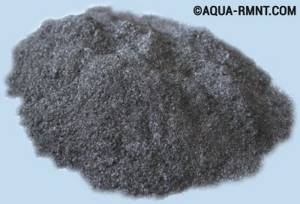
Graphite is crushed and mixed with epoxy glue to create a graphite conductor.
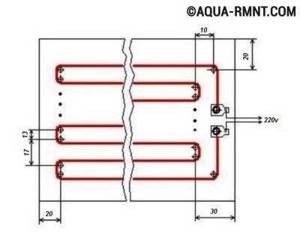
Diagram of the future heating device
Safety of use
Any gas equipment is a potential source of danger. Improper operation or malfunction of the device can lead to serious consequences: fires, smoke and even cylinder explosions.
Therefore, when purchasing a device, you need to pay attention to the protective systems:
- protection when the flame goes out, which ensures that the burner is turned off and the gas supply is stopped;
- Tip over protection – it turns off the gas supply when the device is tilted.
You need to use only reliable and serviceable equipment, branded hoses and reducers, so that there is no accidental gas leakage.
The heating regulator will not be able to protect the cylinder from explosion. However, the risk of emergency situations can be reduced by, for example, never touching with oily hands or spilling oil on the cylinder.
Safety is 90% dependent on human actions. Safety precautions must always be followed. It is strictly forbidden to leave cylinders, gas convectors and heaters unattended, or place them near other heated bodies, flammable objects and liquids. Children should not be allowed to touch the heater, much less play near it.
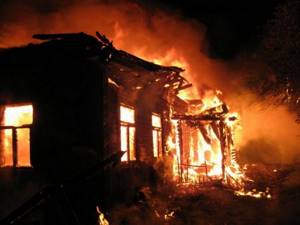
Selection options
Typically, heating equipment is selected according to thermal power. But gas infrared heaters do not have such a wide range of power - from 2 kW to 4.5 kW. However, 4 kilowatt models are recommended for heating an area of 60 square meters. Few people need more powerful installations. So for ordinary rooms - about 20 square meters in area - they usually take 2.3-2.7 kW heaters. And they heat up the air in 20-30 minutes. Depends on the starting temperature and insulation.
What else may be useful:
- Multi-section burner. Most often it has three sections, that is, three operating modes.
- Oxygen monitoring device. Since oxygen is consumed during combustion, and its lack has a negative impact on well-being, oxygen control is a useful thing. Especially if you plan to use the gas infrared heater for a long time or at night.

If there are combustion problems, replace the gearbox with an adjustable one. With its help you can achieve stable operation - CO2 level control system. Carbon dioxide, as you know, has neither color nor odor, and exceeding permissible standards is fraught with poor health. In the worst case, it could end in death. So monitoring carbon dioxide levels is a very useful thing.
- Monitoring the presence of flame and turning off the gas if it is absent. Everything is also clear - no one wants to get gas poisoning.
- Fall sensor. Since there is an open flame on the burner, overturning the unit may result in a fire. Therefore, the presence of such a control device is also desirable.
All these “bells and whistles” cannot be called superfluous. They are found in those devices that are more often called “gas infrared mobile fireplaces.” Most simple and cheap devices do not have them. All control functions remain with the users.
Ignition type
All more or less reputable models of infrared gas heaters have built-in ignition from a piezoelectric element. To make the equipment independent of the presence of electricity, the piezoelectric element is powered by a battery.
Simpler models must be lit using a match, a torch, or any other source of fire. This is not so safe and convenient, although such units are much cheaper.
Availability of fan and electric convector
Some manufacturers of gas infrared heaters offer models with built-in fans. They increase the rate of heating of the room, as the air moves more actively. This is a really useful thing, it helps speed up warming up by about 20-30%.
But not everything is so perfect. First point: fans only work when connected to electricity. The second is that the cost of equipment with a fan is higher. The difference is a couple thousand. At the same time, you can install a regular small fan on the heater body or next to it. Its price will be three to four times lower, but the effect will be the same. Such a “pair” will not look as aesthetically pleasing as with a built-in “wind blower”, but savings may be more important.
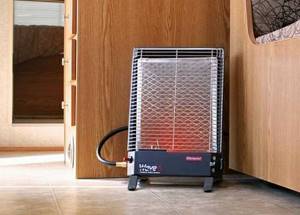
One of the inexpensive options. The heating speed can be increased by placing a fan nearby
Another variation is that an electric convector (Bartolini Primavera I Turbo Plus) is built into the infrared heater. The electric part turns on if the gas part is insufficient. Second application: gas works during the day, electricity at night. This is justified if you are afraid to leave gas equipment running at night. If a night tariff is applied in the region, the cost of heating may not be much more expensive than gas.
